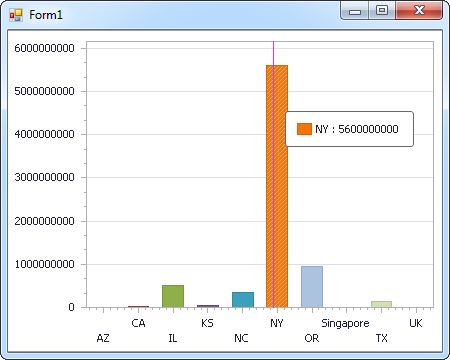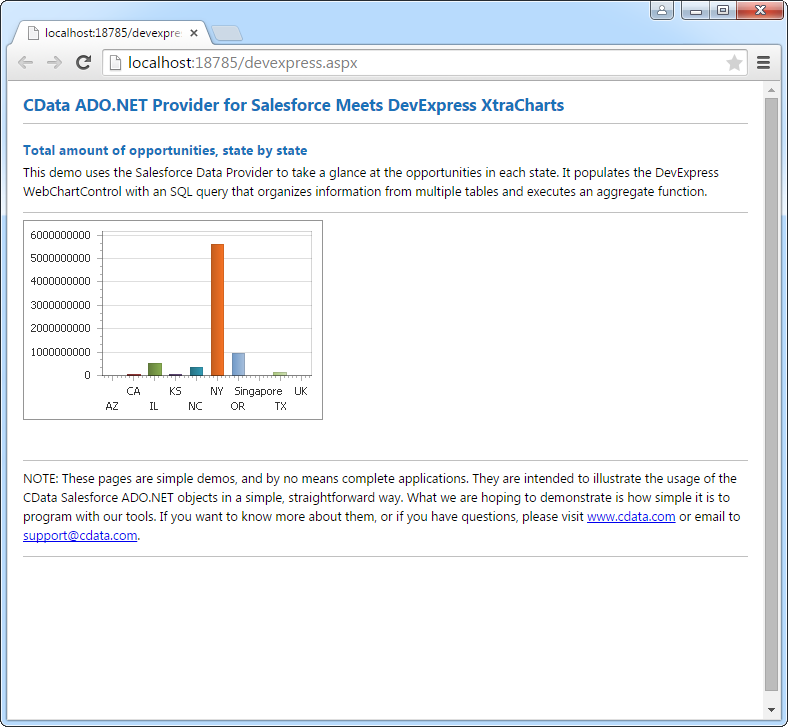Discover how a bimodal integration strategy can address the major data management challenges facing your organization today.
Get the Report →DataBind Salesforce Data to the DevExpress Data Grid
Use the CData ADO.NET Provider for Salesforce with the DevExpress Windows Forms and Web controls to provide Salesforce data to a chart.
The ADO.NET Provider for Salesforce by CData incorporates conventional ADO.NET data access components compatible with third-party controls. You can adhere to the standard ADO.NET data binding procedures to establish two-way access to real-time data through UI controls. This article will demonstrate the utilization of CData components for data binding with DevExpress UI Controls (Windows Forms and Web controls), specifically binding to a chart that visualizes live data.
There are several authentication methods available for connecting to Salesforce: Login, OAuth, and SSO. The Login method requires you to have the username, password, and security token of the user.
If you do not have access to the username and password or do not wish to require them, you can use OAuth authentication.
SSO (single sign-on) can be used by setting the SSOProperties, SSOLoginUrl, and TokenUrl connection properties, which allow you to authenticate to an identity provider. See the "Getting Started" chapter in the help documentation for more information.
Windows Forms Controls
The code below shows how to populate a DevExpress chart with Salesforce data. The SalesforceDataAdapter binds to the Series property of the chart control. The Diagram property of the control defines the x- and y-axes as the column names.
using (SalesforceConnection connection = new SalesforceConnection(
"User=username;Password=password;SecurityToken=Your_Security_Token;")) {
SalesforceDataAdapter dataAdapter = new SalesforceDataAdapter(
"SELECT Contact.Name, SUM(Account.AnnualRevenue) FROM Contact, Account GROUP BY Contact.Name", connection);
DataTable table = new DataTable();
dataAdapter.Fill(table);
DevExpress.XtraCharts.Series series = new DevExpress.XtraCharts.Series();
chartControl1.Series.Add(series);
series.DataSource = table;
series.ValueDataMembers.AddRange(new string[] { "AnnualRevenue" });
series.ArgumentScaleType = DevExpress.XtraCharts.ScaleType.Qualitative;
series.ArgumentDataMember = "Industry";
series.ValueScaleType = DevExpress.XtraCharts.ScaleType.Numerical;
chartControl1.Legend.Visibility = DevExpress.Utils.DefaultBoolean.False;
((DevExpress.XtraCharts.SideBySideBarSeriesView)series.View).ColorEach = true;
}

Web Controls
The code below shows how to populate a DevExpress Web control with Salesforce data. The SalesforceDataAdapter binds to the Series property of the chart; the Diagram property defines the x- and y-axes as the column names.
using DevExpress.XtraCharts;
using (SalesforceConnection connection = new SalesforceConnection(
"User=username;Password=password;SecurityToken=Your_Security_Token;"))
{
SalesforceDataAdapter SalesforceDataAdapter1 = new SalesforceDataAdapter("SELECT Contact.Name, SUM(Account.AnnualRevenue) FROM Contact, Account GROUP BY Contact.Name", connection);
DataTable table = new DataTable();
SalesforceDataAdapter1.Fill(table);
DevExpress.XtraCharts.Series series = new Series("Series1", ViewType.Bar);
WebChartControl1.Series.Add(series);
series.DataSource = table;
series.ValueDataMembers.AddRange(new string[] { "AnnualRevenue" });
series.ArgumentScaleType = ScaleType.Qualitative;
series.ArgumentDataMember = "Industry";
series.ValueScaleType = ScaleType.Numerical;
((DevExpress.XtraCharts.SideBySideBarSeriesView)series.View).ColorEach = true;
}







